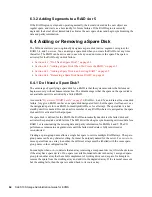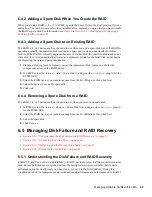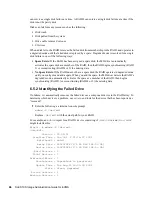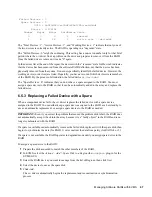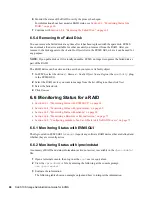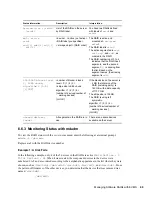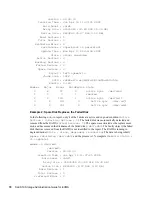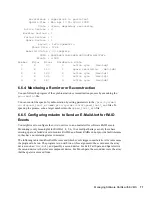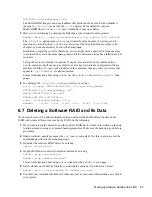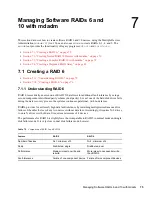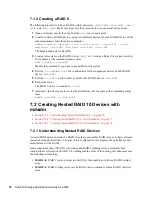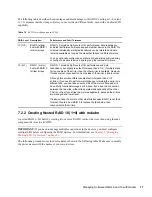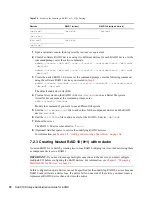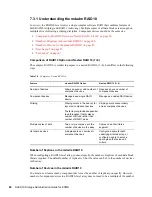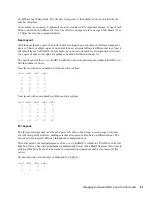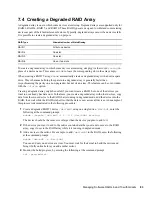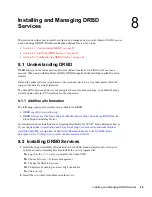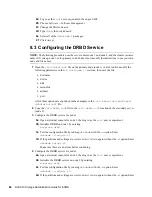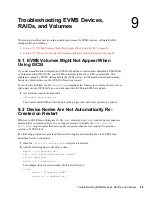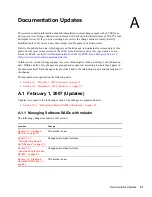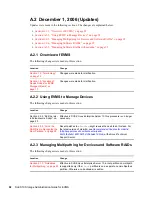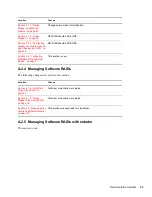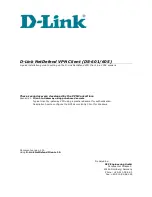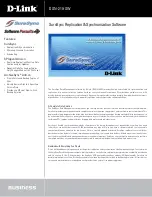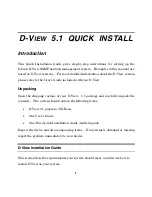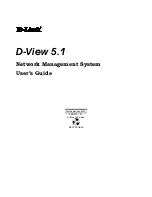
78
SLES 10 Storage Administration Guide for EVMS
no
vd
ocx (
E
NU)
9
Jan
uar
y 2
007
Table 7-3
Scenario for Creating a RAID 10 (1+0) by Nesting
1
Open a terminal console, then log in as the root user or equivalent.
2
Create 2 software RAID 1 devices, using two different devices for each RAID 1 device. At the
command prompt, enter these two commands:
mdadm --create /dev/md0 --run --level=1 --raid-devices=2 /dev/sdb1
/dev/sdc1
mdadm --create /dev/md1 --run --level=1 --raid-devices=2 /dev/sdd1
/dev/sde1
3
Create the nested RAID 1+0 device. At the command prompt, enter the following command
using the software RAID 1 devices you created in
Step 2
:
mdadm --create /dev/md2 --run --level=0 --chunk=64 --raid-devices=2
/dev/md0 /dev/md1
The default chunk size is 64 (KB).
4
Create a file system on the RAID 1+0 device
/dev/md2
, such as a Reiser file system
(reiserfs). For example, at the command prompt, enter
mkfs.reiserfs /dev/md2
Modify the command if you want to use a different file system.
5
Edit the
/etc/mdadm.conf
file to add entries for the component devices and the RAID
device
/dev/md2
.
6
Edit the
/etc/fstab
file to add an entry for the RAID 1+0 device
/dev/md2
.
7
Reboot the server.
The RAID 1+0 device is mounted to
/local
.
8
(Optional) Add hot spares to service the underlying RAID 1 mirrors.
For information, see
Section 6.4, “Adding or Removing a Spare Disk,” on page 64
.
7.2.3 Creating Nested RAID 10 (0+1) with mdadm
A nested RAID 0+1 is built by creating two to four RAID 0 (striping) devices, then mirroring them
as component devices in a RAID 1.
IMPORTANT:
If you need to manage multiple connections to the devices, you must configure
multipath I/O before configuring the RAID devices. For information, see
Chapter 5, “Managing
Multipath I/O for Devices,” on page 41
.
In this configuration, spare devices cannot be specified for the underlying RAID 0 devices because
RAID 0 cannot tolerate a device loss. If a device fails on one side of the mirror, you must create a
replacement RAID 0 device, than add it into the mirror.
Devices
RAID 1 (mirror)
RAID 1+0 (striped mirrors)
/dev/sdb1
/dev/md0
/dev/md2
/dev/sdc1
/
dev/sdd1
/dev/md1
/dev/sde1
Summary of Contents for LINUX ENTERPRISE SERVER 10 - STORAGE ADMINISTRATION GUIDE FOR EVMS
Page 4: ...novdocx ENU 9 January 2007 ...
Page 8: ...8 SLES 10 Storage Administration Guide for EVMS novdocx ENU 9 January 2007 ...
Page 10: ...10 SLES 10 Storage Administration Guide for EVMS novdocx ENU 9 January 2007 ...
Page 40: ...40 SLES 10 Storage Administration Guide for EVMS novdocx ENU 9 January 2007 ...
Page 52: ...52 SLES 10 Storage Administration Guide for EVMS novdocx ENU 9 January 2007 ...
Page 74: ...74 SLES 10 Storage Administration Guide for EVMS novdocx ENU 9 January 2007 ...
Page 84: ...84 SLES 10 Storage Administration Guide for EVMS novdocx ENU 9 January 2007 ...

